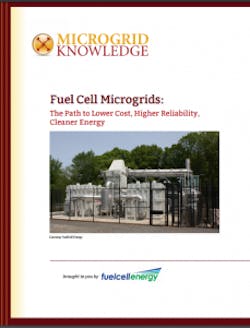An Environmental Case for the Fuel Cell Microgrid: Producing Power with No Combustion
A fuel cell microgrid produces electricity through a chemical reaction — not combustion. This gives it an environmental advantage over many conventional generation technologies, as explained in this excerpt from “Fuel Cell Microgrids: The Path to Lower Cost, Higher Reliability Cleaner Energy.“
A recent study by Argonne National Lab found that fuel cells have lower greenhouse gas emissions than those produced by the U.S. grid mix of technologies.
The same study found that if higher efficiency fuels cells are used, such as those that use solid oxide or molten carbonate technology, the greenhouse gas emissions are comparable to those produced by the California grid mix, which generates 43 percent of its electricity from non-fossil renewable and nuclear sources.
A California wastewater treatment plant, operated by the City of Riverside, offers a good example of the superior environmental performance of a fuel cell. The FuelCell Energy project uses renewable biogas, produced from the wastewater treatment process, as a fuel source to generate carbon-neutral power. As compared to other fuel cells which require ‘directed’ biogas with the same composition as pipeline natural gas, the FCE system operates directly on biogas, thus creating more cost efficiency.
Riverside is located within the South Coast Air Quality Management District, which has the toughest stationary source air emissions requirements in the United States. Because fuel cells do not burn fuel, their emissions are orders of magnitude lower than combustion-based systems. As a result, Riverside’s 1.4 MW fuel cell is exempted from air permitting requirements, even in the strict SCAQMD.
It’s also important to note that the Riverside fuel cell complies with a strict emission requirement of the California’s Self Generation Incentive Program that greenhouse gas emissions be less than 360 kg/MWh.
The key to fuel cells’ low emissions is that the technology does not involve combustion. Fuel cells produce electricity via a chemical reaction.
Hydrogen’s role in a fuel cell microgrid
Fuel cells come in a variety of technologies, including the solid oxide and molten carbonate technologies already mentioned, as well as proton exchange membrane technology and phosphoric acid technologies. The common denominator of all those technologies is hydrogen, which provides the fuel for the fuel cell.
Most commercially deployed fuel cells derive their hydrogen from fuels such as natural gas, but renewable fuels such as biogas can also be used —which is the case in Riverside. It’s also possible to use more conventional fuels such as propane.
When those same fuels are combusted, either in an internal combustion or gas turbine engine, they produce harmful emissions such as carbon monoxide, nitrogen oxides, sulfur dioxide and particulate matter. But because fuel cells use a chemical reaction and not combustion, they produce virtually zero of those pollutants.
Special Report: “Fuel Cell Microgrids: The Path to Lower Cost, Higher Reliability, Cleaner Energy”
Fuel cells do release carbon dioxide (CO2), but as much as 50 percent less than some conventional technologies, due to their inherently high efficiency. In fact, fuel cells in the 1-10+ MW size range are on-par with the CO2 emissions of the cleanest combined cycle gas turbines of 100+ MW and larger, but without the harmful asthma-inducing pollutants which are commonly associated with fossil fuel plants of this size.
In general, fuel cells exceeding 60 percent efficiency, which is typical of molten carbonate and solid oxide fuel cell installations, offer significant reductions in greenhouse gas emissions compared even to the lowest-carbon electric grids in California and the Northeastern US.
The efficiency of a fuel cell microgrid is also a factor in estimating the costs of a system. The higher the efficiency, the less fuel will be required for operation.
Climate concerns heighten interest in fuel cells
All these factors—fuel, cost, emissions —are important considerations in fuel cell microgrid design since a microgrid requires some form of power generation. In the past, diesel generators were often the go-to source, but with heightened concerns about global warming and stricter emissions controls, fuel cells are increasingly at the heart of modern microgrid installations.
Nine states have classified stationary fuel cells as Class I renewable power generation because of their high efficiency and low CO2 emissions. And fuel cells operating on biogas are typically classified as carbon-neutral by regulatory authorities.
In jurisdictions where clean energy is a top priority, such as California and the Northeast where the Regional Greenhouse Gas Initiative operates, the emissions profile and efficiency of fuel cells make them the top pick for microgrid generation.
See “Fuel Cell Microgrids: The Path to Lower Cost, Higher Reliability, Cleaner Energy,” downloadable at no cost, courtesy of FuelCell Energy.
